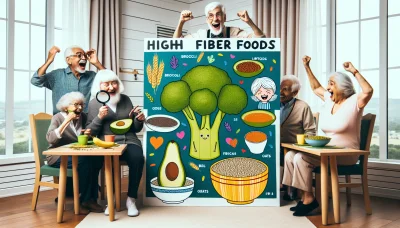High fiber foods for pregnancy Quiz
Test Your Knowledge
Question of
Understanding the Importance of Fiber During Pregnancy
The Role of Fiber in Maternal Health
Fiber is a nutritional powerhouse for expectant mothers, playing a crucial role in maintaining overall health. Its benefits extend beyond basic digestion, impacting various aspects of maternal wellness. Embrace fiber-rich foods to harness these advantages.
Digestive Comfort and Regularity : A pregnant woman's digestive system often requires extra support, and fiber is the unsung hero here. By facilitating regular bowel movements, it reduces the likelihood of constipationa common concern during pregnancy. Remember, a comfortable gut is a happy gut!
Blood Sugar Management : The ebb and flow of blood sugar levels are expertly moderated by fiber's diligent work. This is especially vital during pregnancy as it helps ward off gestational diabetes and ensures a steady supply of energy.
Nutrient Absorption and Utilization : Fiber slows down food transit through the digestive tract, allowing more time for nutrient absorption. It ensures that both mother and baby receive the maximum benefit from their diet.
Daily Fiber Requirements for Pregnant Women
When it comes to daily fiber intake, one size does not fit allespecially for pregnant women whose bodies are working overtime. Understanding the recommended levels and adjusting as pregnancy progresses are key to reaping fiber's full rewards.
Recommended Intake Levels : Health experts typically recommend that pregnant women aim for about 28 to 35 grams of fiber per day. This can be easily achieved through a balanced diet rich in fruits, vegetables, whole grains, and legumes.
Adjusting Intake Throughout Pregnancy : As the baby grows and the body changes, so too may your fiber needs. Listen to your body's cues and adjust your intake accordingly to maintain comfort and health.
- Eat a variety of fiber-rich foods to avoid monotony in your diet.
- Increase fiber intake gradually to allow your body to adjust.
- Stay hydrated! Water works hand-in-hand with fiber.
- Monitor your digestive response to different types of fiber.
- If you're struggling with intake, consider discussing supplements with your healthcare provider.
Types of Fiber and Their Benefits
Fiber comes in two main formssoluble and insolubleeach with its unique properties and benefits for pregnant women. Knowing which foods provide each type of fiber can help you craft a balanced prenatal diet.
Soluble vs. Insoluble Fiber : Soluble fiber dissolves in water forming a gel-like substance that can help lower cholesterol and glucose levels. Insoluble fiber does not dissolve; instead, it adds bulk to stool, which aids in preventing constipation.
Prebiotic Effects on Gut Health : Some fibers serve as prebiotics, nourishing beneficial gut bacteria. A healthy gut microbiome contributes to improved digestion and immune functiona boon for both mother and baby.
Fiber's Role in Weight Management : By promoting feelings of fullness, high-fiber foods can help manage weight during pregnancy. They provide volume without extra calories, helping maintain a healthy weight trajectory for expectant mothers.
Top High-Fiber Foods to Include in Your Pregnancy Diet
Fruits Rich in Fiber
During pregnancy, fiber-rich fruits are a must-have! They promote healthy digestion and provide vital nutrients. Incorporating a variety of fruits into your diet ensures a broad spectrum of vitamins and antioxidants essential for both mother and baby.
Berries and Their Antioxidant Properties : Berries are not just delicious; they're fiber powerhouses! Strawberries, raspberries, and blueberries offer a delightful mix of high fiber and potent antioxidants. These tiny fruits help fight inflammation and protect cells during your pregnancy journey.
Apples as a Convenient Snack : Apples are the perfect on-the-go snack and are brimming with fiber. An apple a day can contribute to your daily fiber intake while also supplying you with vitamin C and quercetin, which supports the immune system.
Pears for Diverse Meal Options : Pears are another excellent source of dietary fiber. They're incredibly versatileenjoy them fresh, baked, or poached. Pears complement both sweet and savory dishes, making them an exceptional addition to your pregnancy diet.
Vegetables That Pack a Fiber Punch
Vibrant vegetables are key components in a high-fiber pregnancy diet. They're low in calories but rich in vitamins, minerals, and of course, dietary fiber. Aim to fill half your plate with veggies to reap their full benefits!
Leafy Greens and Iron Content : Leafy greens like spinach, kale, and Swiss chard are not only fibrous but also iron-packed. Iron is crucial during pregnancy for supporting increased blood volume and aiding fetal development.
Cruciferous Vegetables for Folate : Broccoli, cauliflower, and Brussels sprouts belong to the cruciferous family. They're renowned for their high-fiber content and folate, which is paramount for preventing neural tube defects in newborns.
Root Vegetables as Versatile Ingredients : Root vegetables such as carrots, beets, and sweet potatoes offer substantial amounts of fiber. Their versatility allows them to be incorporated into countless recipesfrom soups to saladsboosting flavor while enhancing nutritional value.
Whole Grains for Sustained Energy
Whole grains should be a staple in your pregnancy diet for their sustained energy release. They contain more fiber than refined grains, helping you feel full longer while providing essential B vitamins and minerals.
- Oats and Their Heart-Healthy Benefits : Start your day with oatsa heart-healthy grain that helps manage cholesterol levels. Oats can be enjoyed in various forms such as oatmeal or granola bars.
- Quinoa as a Protein Source : Quinoa isn't just rich in fiber; it's also a complete protein containing all nine essential amino acids. It's an excellent choice for plant-based diets during pregnancy.
- Brown Rice for Nutrient-Rich Carbohydrates : Brown rice is superior to white rice when it comes to nutritional value. Its high fiber content aids digestion while its carbohydrates provide long-lasting energy throughout your day.
Legumes: A Pregnant Woman's Superfood
Legumes are nutritional powerhouses, essential for pregnant women seeking to optimize their health and the development of their babies. These superfoods pack a punch with high levels of protein, fiber, and essential vitamins and minerals. Including legumes in a pregnancy diet can support fetal growth and help maintain the mother's energy levels and overall well-being. They are incredibly versatile, affordable, and widely available, making them an excellent dietary addition during this crucial time.
For expectant mothers, the benefits of legumes are manifold. They provide substantial folate, vital for preventing neural tube defects in the developing fetus. Legumes also have a low glycemic index, which helps in managing blood sugar levelsa significant concern for gestational diabetes. Moreover, they offer a plant-based alternative to meat proteins, which can be beneficial for those with aversions or dietary restrictions. The inclusion of legumes in a prenatal diet is not just smart; it's a game-changer for maternal and fetal health!
Beans: Varieties and Preparation Methods
Beans are incredibly diverse, with each variety offering unique flavors and benefits. From kidney beans to pinto beans, there's a type to suit every palate and recipe. Preparing beans can be as simple as rinsing canned beans for immediate use or soaking dried beans overnight for a more economical approach. Cooking methods range from boiling and simmering to slow-cooking, which can enhance their texture and taste.
Ensuring beans are well-cooked is crucial as improperly prepared beans can cause digestive discomforta particular concern during pregnancy. Meals like chili, bean salads, or even pureed bean dips are convenient ways to incorporate this nutrient-rich food into your diet. Remember that variety is key; rotating different types of beans will provide a broader spectrum of nutrients.
Black Beans and Their Antioxidant Power
Black beans stand out for their impressive antioxidant properties, thanks to their high anthocyanin content. These antioxidants combat oxidative stress which is particularly important during pregnancy when the body undergoes significant changes. Black beans also contribute to heart health with their rich fiber content that helps lower cholesterol levels.
The versatility of black beans allows them to be used in an array of dishes such as tacos, burritos, soups, and salads. Being high in iron also makes them an excellent choice for supporting the increased blood volume requirements during pregnancy.
Lentils for Easy Digestion
Lentils are particularly beneficial due to their ease of digestion compared to other legumesideal for pregnant women experiencing gastrointestinal sensitivities. They cook quickly without soaking and offer a hearty base for dishes like stews or lentil loafs.
Lentils are packed with essential nutrients like iron and folate that play critical roles in pregnancy. They come in various colors such as green, red, or browneach with its own distinct taste and cooking time but all equally nutritious.
Chickpeas as a Versatile Protein Source
Chickpeas are another fantastic legume choice for pregnant women due to their high protein content which is vital for the growth of fetal tissue. These legumes also provide substantial fiber aiding digestive healtha common concern during pregnancy.
Chickpeas can be enjoyed in many forms: whole in salads or stews, blended into hummus, or even roasted as a crunchy snack. Their mild flavor makes them an easy addition to many recipes without overwhelming other ingredients.
Peas: Nutritional Profile and Recipes
Peas may be small but they're full of key nutrients necessary during pregnancy such as protein, fiber, vitamins A and C, iron, and calcium. They're easy to cook with and add sweetness plus texture to mealsfrozen peas can be quickly steamed or thrown into pasta dishes or casseroles.
Eating peas regularly contributes positively towards meeting nutritional needs without adding excessive caloriesan important consideration when managing weight gain during pregnancy.
Green Peas and Vitamin C Content
Green peas are not only delicious but also an excellent source of vitamin C which supports both the immune system of the mother and the healthy development of baby's bones and teeth. They're incredibly versatilepuree them into soups or add them fresh into salads.
Their natural sweetness pairs well with many flavors making them enjoyable even for those with fluctuating taste preferences common in pregnancy.
Split Peas for Easy-to-Make Soups
Split peas are ideal for simple yet nourishing mealsperfect for expectant mothers who need nutrient-dense yet easy-to-prepare foods. They're often used in comforting split pea soup which can be made in large batches providing several meals throughout the week.
Their high fiber content promotes regular bowel movements reducing constipation risks while also providing steady energy release throughout the dayessential when facing pregnancy fatigue.
Snow Peas as a Crunchy Snack
Snow peas offer a delightful crunch whether eaten raw or lightly sauteda great way to encourage snacking on vegetables during pregnancy! They contain less starch than other peas making them lighter while still delivering beneficial nutrients.
Snow peas work well in stir-fries adding both color and nutrition to your meal without requiring lengthy cooking timesa real plus when you need something healthy but quick!
Nuts and Seeds: Small but Mighty
- Tips:
- Select unsalted varieties to manage sodium intake.
- Incorporate nuts into your diet through spreads like almond butter or by sprinkling seeds over salads or yogurts.
- If you have any history of allergies especially related to nuts consult your healthcare provider before including them in your diet during pregnancy.
- To maximize absorption pair foods rich in iron such as chia seeds with vitamin C-rich foods like strawberries or oranges!
- Avoid processed snacks that may contain nuts but also unhealthy additives; instead opt for whole unprocessed options.
- Moderation is key due to high-calorie counts despite their health benefits too much can contribute to excessive weight gain so keep portions sensible!
Almonds for Calcium Intake
Pregnant women often hear about the importance of calciumand almonds are a fantastic non-dairy source! Just a handful provides substantial amounts contributing towards bone health both for momma-to-be and baby on board!
Beyond calcium almonds also deliver vitamin E magnesium riboflavin among other nutrients making them an all-around stellar snack choice or ingredient addition!
Chia Seeds for Omega-3 Fatty Acids
The omega-3 fatty acids found in chia seeds are critical during pregnancy contributing significantly towards fetal brain development These tiny seeds can be added almost unnoticed into smoothies oatmeal or baking recipes boosting nutritional value effortlessly!
In addition they absorb water creating gel-like consistency which can aid satiety helping control appetite at times when hunger might seem insatiable!
Flaxseeds as a Hormonal Balance Aid
Hormonal fluctuations are synonymous with pregnancy but flaxseeds containing lignans may help balance hormones They're also another great source omega-3s plus soluble fiber aiding digestion!
Easily ground flaxseeds enhance texture flavor while increasing nutrition profile morning cereal breads muffins even meatballs!
Balancing Fiber Intake with Hydration
The Importance of Water During Pregnancy
Fiber is fabulous, but without enough water, it can lead to digestive discomfort. Pregnant women need to increase their water intake to help fiber do its job. Remember, every strand of fiber soaks up water like a sponge, making everything move smoothly through your system.
Preventing Dehydration is paramount during pregnancy. Your body is nurturing a whole new life and needs more fluids than ever. Dehydration can sneak up on you, causing headaches, fatigue, and even contractions. So keep that water bottle handy and sip consistently throughout the day!
Enhancing Fiber's Effectiveness hinges on hydration. Like a dynamic duo in a blockbuster movie, when fiber and water team up, they support each other to maintain your health. This combo not only aids digestion but also helps prevent the dreaded constipation often associated with pregnancy.
Stay alert for Signs of Adequate Hydration : clear or light yellow urine, infrequent headaches, and a sense of well-being. These are your body's ways of giving you a thumbs-up for keeping hydrated!
Juices and Smoothies for Additional Nutrients
Dive into the world of Vegetable Juices as a Hydration Boost . They're not just hydrating; they're packed with vitamins and minerals essential for you and your baby. Plus, they can be incredibly refreshing and a quick way to get your greens!
Fruit Smoothies for Fiber and Hydration are like nature's candy sweet, nutritious, and oh-so-satisfying. Blend together berries, bananas, and a splash of water or coconut water for an irresistible treat that ticks all the right boxes.
It's all about Creating Balanced Drink Recipes . Mix fruits with leafy greens and maybe a bit of ginger for zest. These drinks should make you feel like you've just given your body a big hug full of goodness and love.
Herbal Teas and Their Benefits
Pregnancy-safe Herbal Teas for Pregnancy can be fantastic allies. Think ginger tea for its stomach-settling properties or peppermint tea for that refreshing zing! Just make sure they're safe for pregnancy when in doubt, check with your healthcare provider.
Here's how you Avoid Excessive Caffeine : opt for herbal teas over traditional ones. Too much caffeine isn't ideal when you're expecting; it can cross the placenta and affect your baby's heart rate. So why not explore the wonderful world of herbal infusions instead?
- Soothing Teas for Digestive Comfort:
- Ginger Tea: Known for its anti-nausea benefits, it's great for morning sickness.
- Peppermint Tea: Offers relief from bloating and gas quite the tummy tamer!
- Raspberry Leaf Tea: Often recommended in later pregnancy stages to tone the uterus.
- Lemon Balm Tea: A gentle relaxant that can ease stress and anxiety.
- Dandelion Leaf Tea: A mild diuretic which can help reduce fluid retention.
Managing Fiber Intake to Avoid Discomfort
Recognizing the Signs of Excessive Fiber
Fiber is a fantastic component of a balanced diet, but too much can cause some real bellyaches! If you're experiencing bloating and discomfort, it might be a sign that your body is getting more fiber than it can handle. Listen to your body's signals and consider if your recent diet changes might be the culprit.
Bloating and Gas Issues often hit the stage when you've gone a bit too far with fiber. These are your body's way of saying, "Hold up!" It's crucial to recognize these signs early on to prevent further discomfort. Moderation is key, even with something as beneficial as fiber.
Then there's the Constipation Paradox . It sounds counterintuitive, but too much fiber can actually back things up in your digestive system. If you're feeling constipated, it could be an indication that it's time to ease up on the high-fiber foods and give your system a break.
To avoid these issues, its essential to Adjust Fiber Intake Gradually . Adding fiber to your diet should be a slow and steady journey, not an all-out sprint. This gives your gut time to adapt and reduces the risk of any nasty side effects.
Solutions for Common Fiber-Related Issues
If you've overdone it with the fiber, don't worrythere are solutions! Introducing Probiotics for Gut Health Support can help balance out your digestive system. These tiny warriors work wonders in restoring harmony in your gut flora.
Incorporating regular Physical Activity to Aid Digestion is another game-changer. Exercise isn't just about staying fit; it also keeps everything moving along smoothly in your digestive tract. Make sure to get that heart rate up regularly!
And let's not forget about Mindful Eating Practices for Better Absorption . Chew thoroughly, eat slowly, and pay attention to how foods make you feel. This approach encourages better nutrient absorption and can help mitigate fiber overload issues.
- Eat smaller portions: Large meals can overwhelm your digestive system with fiber.
- Diversify your diet: A variety of foods ensures a balance of both soluble and insoluble fibers.
- Stay hydrated: Water helps fiber do its job without causing blockages.
- Moderate high-fiber foods: Gradually introduce beans, legumes, and whole grains into meals.
- Listen to your body: Adjust intake based on personal tolerance levels.
- Avoid excessive raw foods: Cooking can break down fibers and make them easier to digest.
- Leverage cooking methods: Steaming or boiling can soften fibers in vegetables.
When to Consult a Healthcare Provider
If you're dealing with persistent tummy troubles despite trying all the tricks in the book, it may be time to seek professional advice. Sometimes what feels like simple bloating could be a sign of something more serious. Don't play guessing games with your healthget checked out!
Nutrient absorption concerns are also a valid reason to pick up the phone and make that appointment. Fiber can interfere with how well your body takes in nutrients from food. If you suspect this is happening, a healthcare provider should be involved in sorting things out.
Last but not least, if you need help with dietary adjustments or want personalized advice tailored to your unique needs, healthcare professionals are there for exactly that purpose. They can guide you through creating a plan that works best for you without sacrificing nutrient intake or risking discomfort from too much fiber!
Meal Planning Strategies for High-Fiber Diets
Creating a Balanced Weekly Menu
When aiming for a high-fiber diet, it's critical to plan your weekly menu with balance in mind. Start by including a variety of fruits, vegetables, whole grains, and legumes in your meals. Each of these food groups provides a different set of nutrients along with fiber, ensuring that you get a spectrum of benefits with every dish.
Incorporating variety into your meals is not just about nutrition; it's also about enjoyment! Mix up the types of cuisine you prepare each week to keep your taste buds excited. Experiment with fiber-rich ingredients like quinoa in salads or chia seeds in smoothies. The goal is to create meals that are as appealing as they are healthy.
Incorporating Variety into Meals
Variety is the spice of life, and this holds true when planning your high-fiber meals. Use an array of colorful vegetables to make each plate visually appealing and nutritionally complete. Rotate through different protein sources such as beans, lentils, and nuts to keep things interesting while boosting your fiber intake.
Don't forget about the power of herbs and spices! They can transform simple high-fiber foods into culinary masterpieces. Fresh or dried, herbs like basil, cilantro, or rosemary can elevate the taste of any dish without adding extra calories.
Planning for Snacks and Small Meals
Snacks and small meals are crucial for maintaining energy levels and preventing overeating at mealtime. Prepare high-fiber snacks like carrot sticks with hummus or apple slices with almond butter. These snacks are not only satisfying but also help you reach your daily fiber goals.
Remember that snacks are an opportunity to fit more nutrients into your day. Think beyond the usual fruit and consider snack-sized portions of roasted chickpeas or homemade granola bars that pack a fibrous punch.
Adjusting Portions to Meet Nutritional Needs
Fiber is essential, but too much too quickly can lead to discomfort. Gradually increase your fiber intake and adjust portion sizes according to your body's response. Listen to your body's hunger and fullness cues to determine the right amount for you.
Balancing portion sizes also means paying attention to caloric intake alongside fiber content. It's possible to have a high-fiber meal that's also calorie-dense, so be mindful of incorporating low-calorie, high-fiber foods like leafy greens into your diet.
Tips for Grocery Shopping with Fiber in Mind
- Choosing Whole Foods Over Processed: Always opt for whole fruits instead of juices and choose brown rice over white rice to maximize fiber content.
- Reading Labels for Fiber Content: Look for breads and cereals that list whole grains as the first ingredient and have at least 3 grams of fiber per serving.
- Stocking Up on Fiber-Rich Staples: Keep your pantry filled with oats, lentils, beans, and nuts so you're always ready to whip up a high-fiber meal.
Preparing Meals in Advance
Batch cooking is a lifesaver when it comes to sticking with a high-fiber diet. Dedicate time on the weekend to prepare large quantities of staples like brown rice or quinoa. This way, you'll have a base ready for meals throughout the week.
If you're short on time during the week, freezing prepared meals can be extremely helpful. Make double portions of fiber-rich stews or casseroles and freeze them for later use. This approach ensures that you have healthy options on hand when you need them most.
Batch Cooking for Convenience
Beyond preparing basic ingredients in advance, consider batch cooking entire recipes. Soups loaded with vegetables, beans, and whole grains can be made in large quantities and stored easily. This strategy saves time while ensuring you stay on track with your dietary goals.
Freezing Options for Quick Meals
The freezer is your ally in the quest for consistent high-fiber eating. Freeze individual servings of cooked dishes so they're easy to thaw and reheat. Label containers with dates and contents so you can keep track of what's available at a glance.
Using Slow Cookers for Effortless Dishes
A slow cooker is an invaluable tool for preparing fibrous foods such as beans without constant supervision. Throw in ingredients in the morning, set the cooker on low heat, and come home to a deliciously cooked meal brimming with fiber!
Combining High-Fiber Foods with Other Nutrients
Pairing Fiber with Protein for Satiety
Fiber and protein are a power duo when it comes to satiety and nutrition. Including both in your meals can help you feel full longer, reducing the temptation to snack on less healthy options. High-fiber foods like beans, lentils, and whole grains perfectly complement protein-rich foods.
Lean meats such as chicken breast, turkey, and fish provide high-quality protein that pairs well with fiber-rich vegetables and grains. Plant-based proteins like tofu and tempeh not only offer a protein punch but also bring additional fiber to the plate.
Dairy products like Greek yogurt or cheese can be excellent sources of protein. For those who are dairy-free, alternatives such as almond milk or soy yogurt can fit seamlessly into a high-fiber diet while providing necessary protein.
Eggs are incredibly versatile and can be prepared in numerous ways to accompany high-fiber foods such as whole-grain toast or spinach. They're an affordable source of high-quality protein that can be enjoyed at any meal.
Including Healthy Fats in a High-Fiber Diet
Healthy fats are essential for nutrient absorption and overall health. Avocados, rich in monounsaturated fats, pair excellently with high-fiber foods like whole-grain toast or mixed into salads with leafy greens.
Olive oil is another heart-healthy fat that can enhance the flavor of high-fiber dishes such as grilled vegetables or whole-grain pastas. Its use in cooking not only adds richness but also aids in the absorption of vitamins found in fiber-rich foods.
- Nuts and seeds: Add them to salads, yogurts, or oatmeal for a satisfying crunch.
- Avocado: Use it as a spread on sandwiches or dice it into salads.
- Olive oil: Drizzle it over roasted veggies or mix into vinaigrettes.
- Fish: Opt for omega-3 rich varieties like salmon to pair with fibrous veggies.
- Nut butters: A spoonful can turn a piece of fruit into a filling snack.
- Chia seeds: Sprinkle onto smoothies or make into pudding with almond milk.
Ensuring Adequate Vitamin and Mineral Intake
Prenatal vitamins are crucial for expectant mothers, ensuring they receive nutrients that might be lacking in their diet. Fiber-rich foods should be included to support digestive health during pregnancy, along with these vital vitamins.
Anemia prevention is important; iron-rich foods must be paired with high-fiber diets to prevent deficiencies. Foods like spinach, legumes, and fortified cereals contribute both iron and fiber for a balanced diet.
Bone health is supported by adequate calcium intake. Dairy products are well-known calcium sources; however, leafy greens and fortified non-dairy milks also provide calcium alongside their fiber content. Ensuring diverse sources can cater to various dietary needs while maintaining bone strength.
Addressing Special Dietary Needs and Restrictions
Embracing dietary needs and restrictions is not just a trendit's a way to ensure inclusivity and health for all. Whether due to health conditions, ethical choices, or personal preferences, understanding these needs is paramount. It's thrilling to know that with a bit of knowledge and creativity, everyone can enjoy delicious, high-fiber meals that cater to their specific requirements!
Today's culinary landscape is bursting with alternatives and substitutes that don't compromise on taste or nutritional value. By focusing on variety and whole foods, individuals with special dietary needs can experience a world of flavors while maintaining a balanced diet. Let's dive into the delectable world of gluten-free, vegetarian, vegan, and allergy-conscious high-fiber options!
Gluten-Free High-Fiber Options
Naturally Gluten-Free Grains
Gluten-free doesn't mean grain-free! Quinoa, buckwheat, and brown rice are powerhouses of nutrition that naturally lack gluten. These grains are not only versatile but also packed with fiber, making them ideal for anyone looking to enhance their diet while adhering to gluten-free guidelines.
These grains can be the cornerstone of any mealfrom hearty breakfast bowls to satisfying dinner dishes. Experimenting with these grains can unlock a treasure trove of gluten-free delights that will keep your menu fresh and exciting!
Gluten-Free Breads and Pastas
The rise of gluten-free baking has brought about breads and pastas that rival their wheat-based counterparts in both texture and flavor. Ingredients like almond flour, coconut flour, and rice flour have revolutionized the gluten-free scene. Now you can indulge in your favorite pasta dishes and sandwiches without the worry!
Sourcing these products has never been easier, as supermarkets now boast an impressive range of gluten-free options. Be sure to check labels for added fibers to make these choices even more gut-friendly!
Safe Snacking on a Gluten-Free Diet
- Fruits and Nuts: A perfect combo of natural sweetness and crunchiness.
- Rice Cakes: Top them with avocado or hummus for an extra fiber boost.
- Popcorn: Choose plain varieties to avoid hidden gluten in flavorings.
- Yogurt with Chia Seeds: A probiotic-rich snack that's great for digestion.
- Veggie Sticks: Dip in gluten-free dressings for a refreshing crunch.
High-Fiber Foods for Vegetarians and Vegans
Plant-Based Protein Sources
Lentils, chickpeas, and beans are not only rich in protein but also brimming with fibera win-win for vegetarians and vegans alike! These nutritional champions can form the backbone of countless recipes while providing essential nutrients.
Incorporating these protein sources into meals ensures a satisfying eating experience that supports overall health. They're truly a testament to the versatility and richness of plant-based diets!
Dairy Alternatives Rich in Fiber
Dairy alternatives like almond milk or oat milk can offer additional fiber while keeping meals plant-based. Many of these alternatives come fortified with calcium and vitamin D, ensuring no compromises on nutrition.
Oat milk especially stands out as it naturally contains beta-glucansa type of fiber known for its heart-healthy benefits. Choosing the right dairy alternative can enrich your diet beyond simple nutrient replacement.
Balancing Macronutrients without Meat
Balancing macronutrients in a meatless diet is an exhilarating challenge with delicious rewards. Whole grains, seeds like flaxseed or hemp seed, nuts, and legumes are all incredible sources of fiber that also contribute healthy fats and proteins.
Crafting meals around these ingredients ensures a well-rounded diet full of flavor and texture. It's all about mixing different food groups to meet your nutritional needs while keeping things exciting on the plate!
Managing Food Allergies and Intolerances
Identifying Allergens in High-Fiber Foods
Navigating food allergies requires vigilanceespecially when it comes to high-fiber foods which may contain common allergens like nuts or soy. Reading labels thoroughly is key; many products now clearly highlight potential allergens for safety.
This awareness allows individuals with food allergies to enjoy fiber-rich diets without compromising their well-being. Always be proactive about understanding ingredient listsit's a crucial step towards allergy-safe eating!
Substituting Common Allergens
The art of substitution is essential when dealing with food allergies. Ingredients such as sunflower seeds or pumpkin seeds can replace nuts; similarly, there are numerous soy-free protein options available like pea protein.
Creativity in the kitchen leads to satisfying meals that adhere to dietary restrictions while providing necessary nutrients like fiberso lets get innovative!
Working with a Dietitian for Custom Plans
The guidance of a registered dietitian can be invaluable when customizing high-fiber meal plans tailored to specific allergies or intolerances. They possess the expertise to ensure balanced nutrition while taking into account individual restrictions.
A personalized approach ensures you don't miss out on vital nutrients or culinary enjoyment despite your dietary limitationsseeking professional advice could be one of your best decisions!












